bengkulu, pontianak, lampung. Obat-obat yang mengadung empedu beruang sebagian besar diimpor dari cina dan dijual dengan harga bervariasi antar Rp.70.000-
Rp. 300.000.
Meski Bengkulu memiliki kawasan konservasi yang luas, namun perlindungan terhadap jenis satwa liar sangat buruk. Para pemburu harimau, badak dan beruang
biasanya menggunakan kedok sebagai pemburu babi hutan. Perdagangan Penyu juga terus terjadi di perbatasan Sumbar – Bengkulu. Meski seluruh jenis penyu laut dan bagian - bagiannya telah dilindungi namun perdagangan telur penyu masih terjadi dengan bebas dan tidak terkendali.
Daftar sebagian dari catatan hitam yang panjang dari propinsi Bengkulu untuk perlindungan satwa dan flora bisa di baca di : http://www.pili.or.id/incl_indo_read_detail.php?id=189
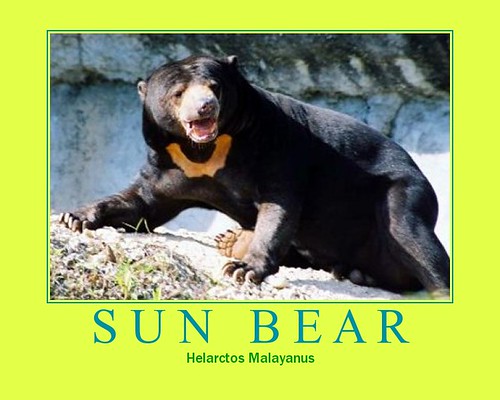
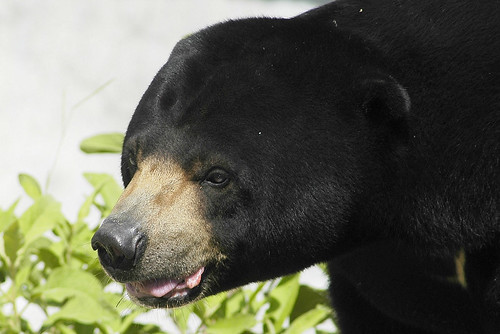

By LeeAnn Bies

Geographic Range
Helarctos malayanus ranges from the eastern Himalayas to Szechuan in China, then southward throughout Burma, parts of Indochina and the Malayan peninsula. Their range is probably greater than what is actually known. (Sanderson, 1972; Ward and Kynaston, 1995)
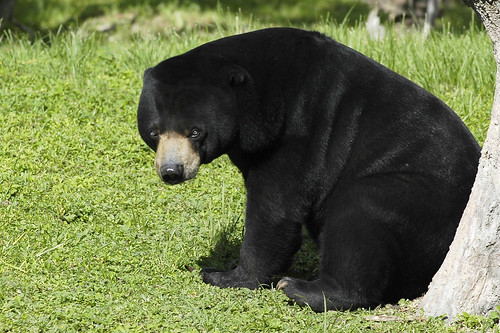
Habitat
Sun bears are found in dense lowland tropical forests. They can commonly be found climbing in trees. (Sanderson, 1972)
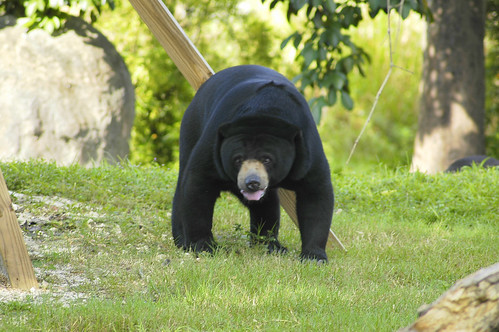
Physical Description
(59.4 to 143 lbs)
(3.94 to 4.92 ft)
Sun bears are the smallest bears in the family Ursidae. They stand 70 cm at the shoulder and are 1.2 to 1.5 m from head to tail. The tail itself is 3 to 7 cm. Males are larger than the females but only by 10 to 20%. They have short, wide, flat heads with small round ears. Their fur is rather coarse but appears sleek. This coat is entirely black except for a "U" shaped patch on the chest and a grey to faintly orange muzzle. The yellowish or white chest patch is highly variable, "U" shaped in some and completely absent in others. This mark may exaggerate bears' sizes during fights. The young are born with soft, shiny coats. The paws are fairly large with sickle-shaped claws and naked soles which are thought to be helpful in climbing trees. These bears have an interesting walk, with all four legs turned in while walking. (International Association for Bear Research and Management (IBA), 1999; Nowak, 1997; Sanderson, 1972; Ward and Kynaston, 1995)

Reproduction
Frequency of breeding in females is unknown.
Breeding occurs throughout the year.
Little is known about mating in sun bears.
Little is known about the reproductive behavior of sun bears in the wild. Gestation period lasts about 95 days, but there is evidence of delayed implantation. Some sun bear pregnancies in a zoo in Fort Worth lasted 174 to 240 days. A sun bear at the Berlin Zoo actually gave birth two times in one year in 1961, first in April, then again in August, but this is rare. Litter size is usually around one to two but occasionally there are three. Newborns are blind, hairless, and helpless and weigh a mere 300 grams. Cubs stay with their mothers until fully grown and reach sexual maturity around three years of age. (International Association for Bear Research and Management (IBA), 1999)
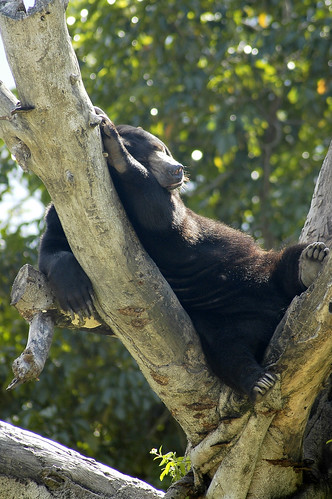
Lifespan/Longevity
In captivity sun bears have lived up to 24 years and nine months. (Helin, 1999)
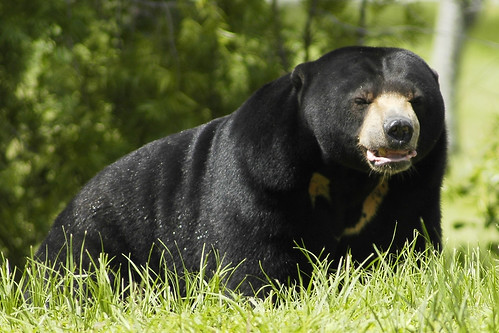
Behavior
Sun bears are active at night and are excellent and agile climbers. They sleep and sun bath in trees at heights from 2 to 7 m. This species does not go through periods of hibernation, probably because they live in tropical areas and their food sources are present year round. (Nowak, 1997; Sanderson, 1972)
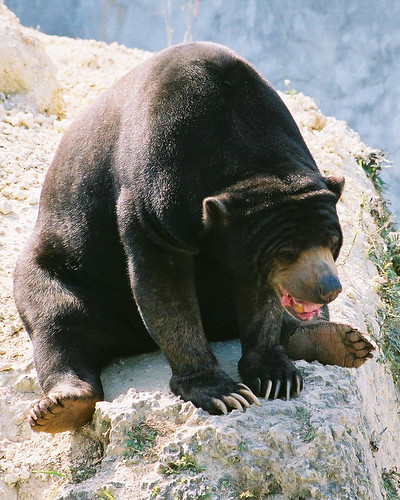
Communication and Perception
Like other bear species, sun bears have a keen sense of smell. Bears tend to use their senses of smell and touch to find and manipulate food. They probably use olfactory cues to find potential mates and use some vocalizations. (Nowak, 1997)

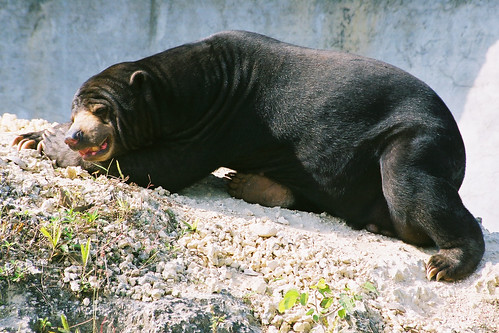
Food Habits
Sun bears are opportunistic omnivores, with bees, termites, and earthworms comprising the main part of their diet. Fruit is also eaten when available. The former are more regular food sources than fruit and usually there is no need for H. malayanus to cover great distances in their search for food. These bears have long tongues that are helpful for obtaining insects from trees, termites from their nests, and honey from bee hives. Should the opportunity present itself, sun bears will eat small rodents, birds, and lizards along with scavenging tiger kills. In human populated areas their diet may include rubbish, livestock, and agricultural fruit such as bananas. (Ward and Kynaston, 1995)

Predation
Predation on sun bears is not reported. Because of their size they are likely to have few natural predators. Young bears may be killed by aggressive conspecifics or by tigers.
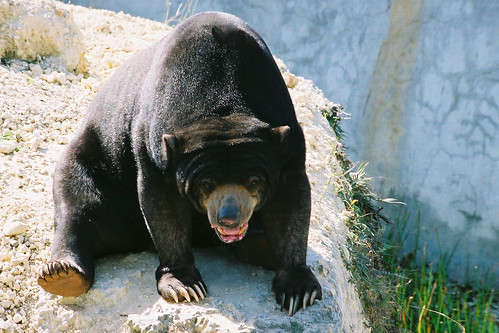
Ecosystem Roles
In certain regions, sun bears are important in seed dispersal. In a study of H. malayanus in Borneo, one sample of these bear feces was found to contain 309 seeds of a certain species of plant. They also impact the colonial insect populations that they prey on. (McConkey and Galetti, 1999)
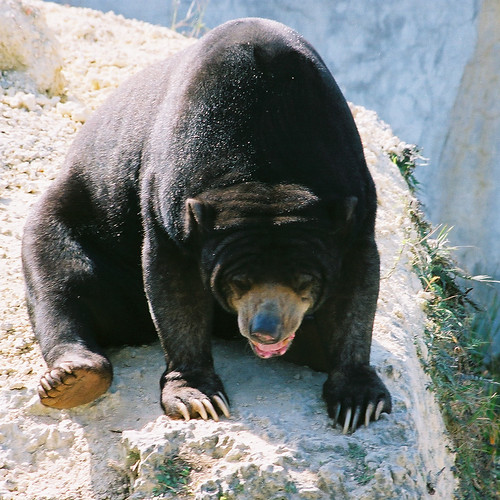
Economic Importance for Humans: Negative
Sun bears have been known to cause damage to crops such as oil palms, coconuts, and bananas.
Ways that these animals might be a problem for humans:
crop pest.
Economic Importance for Humans: Positive
The gall bladders and other body parts of sun bears are used in folk medical practices. It has been proven, though, that they have no medicinal value. People hunt them for sport and profit. They are commonly sold as pets when they are cubs, but quickly outgrow the stage when they are manageable as pets. (Sanderson, 1972)
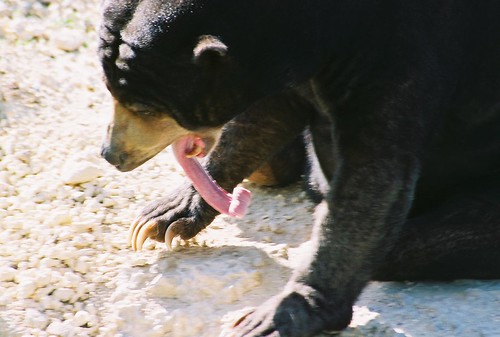
Conservation Status
IUCN Red List: [link]:
Data Deficient.
US Federal List: [link]:
No special status.
CITES: [link]:
Appendix I.
Sun bears are one of the rarest bears. The exact number alive today is not known, but the population is steadily declining due to deforestation and hunting. Habitat destruction is causing these bears to live in smaller and more isolated patches. The land is being cleared to create coffee, rubber and oil palm plantations. Poachers are flocking to protected areas and reserves because they know there are bears there. Reserves may not even be providing sufficient habitats for these bears because their needs are not completely known. Not many conservation attempts have been done to save these bears because so little is known about them. (Servheen Christopher, March/April 1999; Ward and Kynaston, 1995)
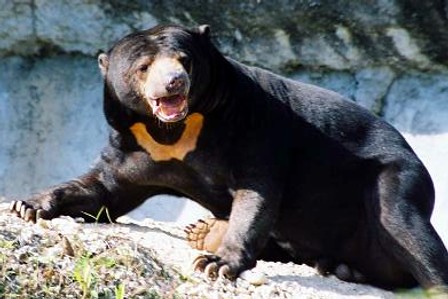
Other Comments
One sun bear demonstrated his intelligence while in captivity. This particular bear took the rice that was given to him for food and scattered it on the ground. There were also chickens in this bear's lair and the scattered rice attracted these chickens, which the bear then captured and ate. (Nowak, 1997)


Contributors
LeeAnn Bies (author), University of Michigan.
Cynthia Sims Parr (editor), University of Michigan. Tanya Dewey (editor), Animal Diversity Web, University of Michigan Museum of Zoology.








Sun Bear at the MiamiMetro Zoo
http://flickr.com/photos/ucumari/140318520/in/set-72157594220710793/
http://animaldiversity.ummz.umich.edu/site/accounts/information/Helarctos_malayanus.html











0 comments:
Post a Comment